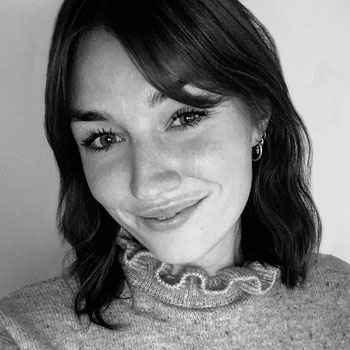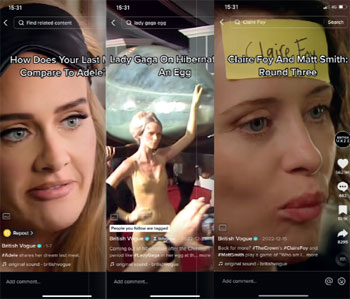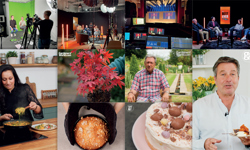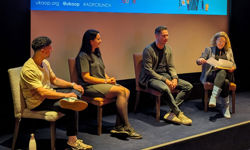
Do you want to watch a blindfolded Adele tasting spotted dick? Find out what Kate Moss keeps in her handbag? Or discover what Stormzy wore when he was younger? Look no further than British Vogue’s video channel, an extension of the iconic fashion brand that offers an intimate and often funny peek into the lives of the beautiful and famous.
Minnie Carver, director of programming, development & creative production at British Vogue is the creative force behind the magazine brand’s YouTube video channel and more recently its forays into the world of TikTok.
She sees video as part of a 360 approach to the Vogue brand, sitting alongside print, digital, social media and consumer events. What unites all these elements is editor Edward Enninful’s vision, which she encapsulates as “about diversity of perspective and championing voices both established and emerging across the industries which are shaping our future”.
She adds: “Vogue as a brand has a 106-year history and is recognised as the fashion bible. With both print and digital, we’re constantly innovating and keeping up with the ever-changing face of fashion and how it intersects with art, lifestyle, politics and pop-culture.”
But while print and digital are two halves of the same whole, they require different approaches because of the ways in which they are consumed. When readers buy a magazine, it is a luxury financial investment they are willing to spend time on. With video, however, Carver explains, “we’re competing against the rest of the content which is flooding our consumers’ screens, and the way that it’s digested is a lot less intentional”.

This presents her with the difficult task of engaging people’s attention within a couple of seconds. When it comes to Tik Tok, the best performing clips are an average of just 17 seconds long. The YouTube channel allows for longer form, more polished content, but even this is measured in minutes.
One upside of video is the access it provides to extensive data analytics. With YouTube, as well as the baseline number of views, you can see how long an average person has spent watching a video, where they live, and their age and sex. Carver and her small three-person team including a producer and editor can use this information to understand their audience better and adapt their strategy accordingly.
That video strategy is to inform, entertain and engage with high quality content that provides exclusive access and unique insights. On the YouTube channel, series such as ‘In The Bag’ have proved incredibly popular. This involves top talent, from Kate Hudson to Emma Watson, and Pamela Anderson to Florence Pugh, emptying their handbags in front of the camera, giving viewers a glimpse into their lives, from jangling car keys and preferred skincare products, to healing crystals and aspirational reading.
Production values
The YouTube videos are shot in an artistic style, like mini director’s cuts. TikTok on the other hand has been a steep learning curve for the team.
Carver says: “We’ve found that the more glossy and high production value it is, the less impact it tends to have. It’s a completely different way of thinking, producing, and it feels a lot freer. I love making content for both, but it’s nice to have the contrast. It’s also been fun to establish British Vogue’s tone of voice within the TikTok realm. Unlike a lot of our other platforms, we have been pushing the comical angle and making lots of meme style content which is not something we had done in the past. It’s a way of the team brainstorming and coming up with silly ideas which work well. We’ve had to learn new ways of ideating and creating content which is very different to our YouTube offering. A lot less emphasis is placed on production value and making it look glossy. We’ve found the key to success is with much more lo-fi, snappy content that feels accessible. That’s been liberating for us and a new way of working.”

With Fashion Week, for example, they have found that taking short video clips and repurposing them into a meme-like format has proved successful. Video in general attracts a younger audience than print or other online platforms, while within that, TikTok skews younger than YouTube.
“As with all our video platforms, we do have to uphold the Vogue brand. It is about luxury and showcasing the zeitgeist and you do have to have that premium feel to it. But it’s been about weaving in a different tone and personality to what we would have on Instagram for example, to tap into that younger demographic,” says Carver.
When it comes to longer form, what makes a successful video is having a format that feels natural and allows the talent to relax in front of the camera in a way they might not in a more straightforward Q&A.
Carver says: “With ‘In The Bag’, the success is largely due to the fact that each person’s bag is unique to them and reflects their character and lifestyle. There’s a great deal of variety between each of the episodes in the series. With Kate Moss’s, over half a million people have seen what’s in her bag and at the same time got an insight into her incredible life, career, personality, which not many people were familiar with. That’s such an amazing piece of access. As Vogue, we’re uniquely positioned to offer this and super lucky to work with talent who are happy to open up to us. Creating a relaxed and positive atmosphere on set is key to achieving this, so that you can get under the skin and get to know somebody.”
In another video, Stormzy sits in an empty cinema with his stylist, watching films of the outfits he wore in his early music videos while eating popcorn, allowing the viewer to see him in a more casual environment.
While there is a distinctly British flavour to the videos produced by Minnie and her team, they often feature Hollywood talent, reflecting the fact that she reports to Thespena Guatieri, Vogue’s VP, video, in Los Angeles. Some series are shared such as ‘Life in Looks’, but most are unique to Britain or the US. Popular series on the US Vogue video channel include ‘Beauty Secrets’, revealing the skincare routines of familiar faces, and ‘73 Questions’, rapid-fire questions filmed in a single shot, often in a star’s own home.
Lead times vary hugely. With TikTok, they aim to put up at least one video a day. Key videos are finalised at the beginning of the week. If they are linked to events such as Fashion Week, speed is of the essence, with the team aiming to get video up “as soon as humanly possible”. In contrast, access to cover stars is planned months in advance, giving Carver and her team plenty of time to come up with ideas.
The dream scenario
“From an ideation standpoint, as soon as we know we have access to a certain talent, we’ll start concepting. With the print led cover for example, it could be up to a year before the video launches,” she says.
When pitching ideas to talent, she prefers a tiered approach. There is the dream scenario, the most practical idea, and a worst-case bare minimum in case they have very little time.
“I’ve had the dream option come to fruition a few times and that’s so satisfying when you put forward an idea that you assume there’s no way they would do, and they go ahead with it,” she says.
These include the ‘Ultimate British Taste Test with Adele’, who was blindfolded and asked to identify a range of traditional dishes on camera, including cockles, kippers, pork pie and Eton Mess. Another of Carver’s personal favourites was persuading supermodel sisters Gigi and Bella Hadid to take a sculpture challenge, modelling their favourite foods and accessories out of clay.
“With talent like that, you see them so much, they’ve done so many different formats, I was like, ‘what could we do that no one’s done?’. They were so up for it and it’s a really successful video,” she says.
“The same with Adele’s taste test. She went for it, and it was brilliant and one of our most successful videos. Those are the videos that do well, seeing people you recognise in a totally different context of having fun and getting to know them in a new way.”
Carver’s own career path to her current role began at the Glasgow School of Art, where she studied painting and printmaking. She believes these disciplines have a lot in common with filmmaking.
“Both are a storytelling mechanism designed to evoke an emotion from the viewer and you have to think about lighting and narrative,” she says.
Following an internship at the cutting-edge video channel Nowness, she was employed full time as part of their creative team. She went on to become a creative director at media production company Good Egg, working on music videos and commercials before joining Vogue as a video producer in 2017.
Her advice to other publishers hoping to follow in the footsteps of British Vogue and create successful video content, would be to establish franchises that can be rolled out regularly. These form the foundation of your content offering, which you can then build on with other exclusives and one-offs.
Going forward, British Vogue has lots of exciting new ideas for video content in the pipeline.
“We’re always pushing and trying to come up with new ideas and deepen our connection with our audience and thinking proactively about where and how we’re providing for them,” Carver explains.
This article was first published in InPublishing magazine. If you would like to be added to the free mailing list to receive the magazine, please register here.












